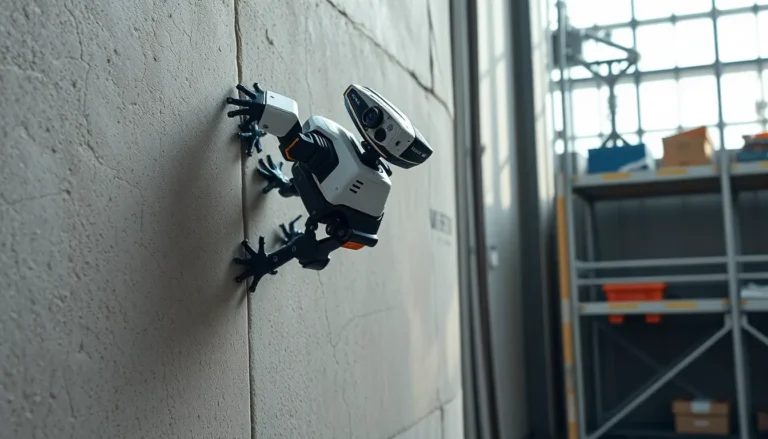Robotics is no longer just the stuff of sci-fi movies. It’s a thriving field that’s transforming industries and redefining our daily lives. From the friendly vacuum that zips around the house to the complex machines assembling cars, robotics comes in various shapes and sizes, each with its own unique flair.
Table of Contents
ToggleOverview of Types of Robotics
Robotics encompasses various types, each designed for specific tasks and industries. Industrial robotics focuses on automation within manufacturing environments. These machines perform repetitive tasks like welding, painting, and assembly with high precision and speed.
Service robotics operate in environments that require human interaction or assistance. These robots include vacuum cleaners, lawn mowers, and healthcare assistants. They enhance everyday life by performing tasks that improve convenience and efficiency.
Collaborative robots, or cobots, work alongside humans in shared spaces. They assist in tasks ranging from picking and packing to assembly, enhancing productivity while prioritizing safety. Cobots adapt to various workflows, making them versatile in different settings.
Exploration robots serve in environments that are hazardous or inaccessible to humans. These devices include planetary rovers and underwater drones, gathering data for scientific research and exploration. Their design allows them to navigate challenging terrains and perform complex tasks.
Educational robotics promotes hands-on learning experiences. Students use these robots to understand programming, engineering, and robotics concepts. Tools like LEGO Mindstorms or VEX Robotics kits exemplify this category, engaging learners in STEM activities.
Research robotics involves developing new technologies and methodologies. Academic institutions and corporations leverage these robots for experiments and innovation in fields like artificial intelligence and machine learning. Their contributions drive advancements in the robotics sector.
Agricultural robotics focuses on modernizing farming practices. These machines automate planting, harvesting, and monitoring crops, increasing efficiency and yield. Examples include drone crop monitors and autonomous tractors, which help manage large agricultural operations effectively.
Industrial Robotics

Industrial robotics play a crucial role in automation within various manufacturing sectors. These robots perform tasks with precision, speed, and efficiency, significantly enhancing production capabilities.
Applications in Manufacturing
Applications in manufacturing span several processes including assembly, welding, painting, and material handling. Robots excel at repetitive tasks, ensuring consistency in quality and reducing human error. By integrating robotics into production lines, manufacturers can increase output while minimizing downtime. For example, automotive plants utilize robotic arms for tasks like spot welding, resulting in faster assembly times. Additionally, robotic systems can operate in hazardous environments, reducing risks to human workers and enabling continuous production cycles.
Types of Industrial Robots
Types of industrial robots include articulated robots, Cartesian robots, and delta robots. Articulated robots feature rotary joints, allowing them to perform complex movements. Cartesian robots consist of linear axes, typically used for pick-and-place applications. Delta robots have a parallel-link design that enables rapid movement, often seen in packaging and sorting tasks. Each robot type serves specific functions based on the requirements of the manufacturing process, optimizing production efficiency and resource allocation.
Service Robotics
Service robotics encompasses robots designed to assist with various tasks, significantly improving daily life and operational efficiency across numerous environments. These robots fall into two distinct categories: personal service robots and professional service robots.
Personal Service Robots
Personal service robots enhance individual convenience in everyday tasks, promoting efficiency in home settings. Robotic vacuum cleaners exemplify this trend, autonomously navigating spaces to perform cleaning duties. Additionally, robotic lawn mowers handle outdoor maintenance, eliminating manual labor. Other examples include personal assistants, such as robotic companions that engage users in conversation. As technology advances, personal service robots increasingly integrate features like voice recognition and smart home connectivity, making them essential in modern households.
Professional Service Robots
Professional service robots operate in various industries, supporting tasks that require precision and agility. Healthcare robotics plays a crucial role in this category, with surgical robots assisting in complex procedures and enhancing surgical accuracy. Logistics and delivery robots streamline supply chain operations by transporting goods efficiently within warehouses. Robots also help in hospitality settings, providing information and services to guests in hotels. The integration of advanced sensors and AI allows these robots to adapt to dynamic environments, increasing productivity across sectors.
Medical Robotics
Medical robotics encompasses various robotic applications designed to improve healthcare delivery. This field includes technologies that enhance surgical precision, assist in rehabilitation, and streamline patient care.
Surgical Robots
Surgical robots provide critical assistance in minimally invasive procedures. These devices enhance the surgeon’s ability to perform delicate tasks with greater precision and control. For instance, the da Vinci Surgical System allows surgeons to operate through tiny incisions, resulting in less pain and quicker recovery for patients. Furthermore, these robots offer real-time imaging and surgical data analysis, enhancing overall operational effectiveness. Hospitals that integrate surgical robots often experience reduced complication rates and shorter hospital stays.
Rehabilitation Robots
Rehabilitation robots play a vital role in patient recovery and physical therapy. These devices assist individuals in regaining movement and strength after injuries or surgeries. Technologies such as robotic exoskeletons help patients relearn how to walk, providing support and motivation during rehabilitation sessions. Various studies demonstrate that patients using rehabilitation robots achieve improved outcomes compared to traditional therapy methods. Facilities that utilize these robots often track significant advancements in patient mobility and overall satisfaction with their recovery process.
Exploration Robotics
Exploration robotics involves specialized robots designed to gather data in inaccessible or hazardous environments. These robots play a crucial role in advancing scientific research across various domains.
Space Exploration Robots
Space exploration robots facilitate missions beyond Earth’s atmosphere. Rovers such as Curiosity and Perseverance have successfully navigated the Martian landscape, conducting soil and atmospheric analyses. Each rover employs advanced instrumentation to send critical data back to Earth. Satellites orbiting planets collect images for mapping and climate studies. These robotic systems enable researchers to explore extraterrestrial terrains without risking human life.
Underwater Exploration Robots
Underwater exploration robots operate in the depths of Earth’s oceans, revealing vital information about marine ecosystems. Remotely operated vehicles (ROVs) are commonly utilized for deep-sea research. Each ROV features high-definition cameras and specialized tools for sampling and analysis. Unmanned underwater vehicles (UUVs) facilitate autonomous missions, collecting data in environments where human divers cannot operate. These robots contribute to understanding biodiversity and geological formations beneath the waves.
Robotics has transformed from a fictional idea into a vital force shaping various sectors. The different types of robotics, including industrial, service, medical, exploration, and educational, highlight the versatility and impact of these technologies. Each category serves distinct purposes that enhance efficiency and improve quality of life.
As robotics continues to evolve, its integration into everyday tasks and complex environments will likely expand. This progress not only promises to streamline operations across industries but also opens new avenues for innovation and exploration. The future of robotics is bright and full of possibilities, making it an exciting field to watch.




